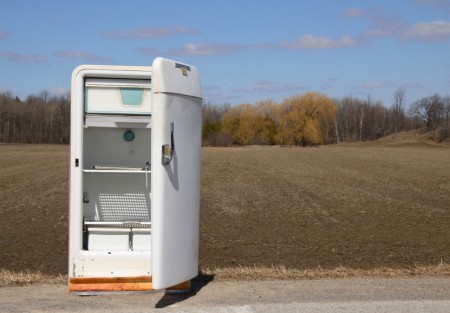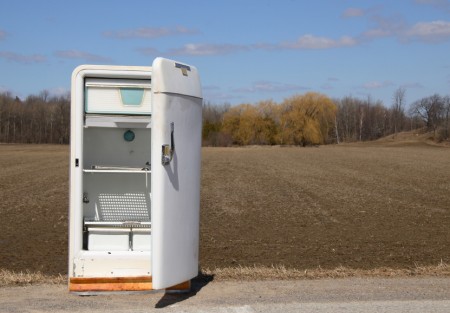 Kick old, energy-inefficient refrigerators to the curb — and curb your energy costs and carbon emissions too.
Kick old, energy-inefficient refrigerators to the curb — and curb your energy costs and carbon emissions too.
There are enormous opportunities to use energy more efficiently. Investing in energy efficiency is often far cheaper than expanding the energy supply to meet growing demand. Efficiency investments typically yield a high rate of return, saving consumers money, and can help fight climate change by avoiding carbon dioxide (CO2) emissions from burning additional fossil fuels. Just as compact fluorescent lamps (CFLs) offer great electricity savings over incandescent light bulbs, a similar range of efficiencies is available for many household appliances, such as refrigerators and home electronics.
The U.S. Energy Policy Act of 2005 was designed to exploit some of these potential savings. It raises appliance efficiency standards high enough to close 29 power plants that burn coal, the most carbon intensive of the fossil fuels. Other provisions in the act — such as tax incentives that encourage the adoption of energy-efficient technologies, a shift to more combined heat and power generation, and the adoption of real-time pricing of electricity (a measure to discourage optional electricity use during peak demand periods) — would cut electricity demand enough to close an additional 37 coal-fired power plants. Appliance efficiency standards and other measures in the bill would also reduce natural gas consumption substantially. All together, these measures are projected to reduce consumer electricity and gas bills in 2020 by more than $20 billion.
Although the U.S. Congress passed legislation raising efficiency for some 30 categories of household and industrial appliances — from refrigerators to industrial-scale electric motors — the U.S. Department of Energy (DOE) has for many years failed to write the standards needed to actually implement the legislation. To remedy this, just days after taking office, President Obama ordered the DOE to write regulations to translate law into policy.
Globally the big appliance challenge is China. In 1980 its appliance manufacturers produced only 50,000 refrigerators, virtually all for domestic use. In 2008 they produced 48 million refrigerators, 90 million color TVs, and 42 million clothes washers, many of which were for export.
Market penetration of these modern appliances in urban China today is already similar to that in industrial countries. For every 100 urban households there are 138 color TV sets, 97 washing machines, and 88 room air conditioners. Even in rural areas there are 95 color TVs and 46 washing machines for every 100 households. This phenomenal growth in household appliance use in China, along with the extraordinary growth of industry, raised China’s electricity use 11-fold from 1980 to 2007. Although China established standards for most appliances by 2005, these are not strictly enforced.
The other major concentration of home appliances is in the European Union, home to 495 million people. Greenpeace notes that even though Europeans on average use half as much electricity as Americans do, they still have a large potential for reducing their usage. A refrigerator in Europe uses scarcely half as much electricity as one in the United States, for example, but the most efficient refrigerators on the market today use only one-fourth as much electricity as the average refrigerator in Europe, suggesting a huge potential for cutting electricity use.
But this is not the end of the efficiency trail, since advancing technology keeps raising the potential. Japan’s Top Runner Program is the world’s most dynamic system for upgrading appliance efficiency standards. In this system, the most efficient appliances marketed today set the standard for those sold tomorrow. Using this program, between the late 1990s and the end of 2007 Japan raised efficiency standards for individual appliances by anywhere from 15 to 83 percent, depending on the appliance. This is an ongoing process that continually exploits advances in efficiency technologies. A 2008 report indicates that the Top Runner Program for all appliances is running ahead of the ambitious initial expectations — and often by a wide margin.
In an analysis of potential energy savings by 2030 by type of appliance, the Organization for Economic Co-operation and Development (OECD) put the potential savings from reducing electricity for standby use — the power consumed when an appliance is not being used — at the top of the list. The electricity used by appliances in standby mode worldwide accounts for up to 10 percent of total electricity consumption. In OECD countries, individual household standby power ranged from a low of perhaps 30 watts to a high of over 100 watts in both U.S. and New Zealand households. Since this power is used around the clock, even though the wattage is relatively low, the cumulative use is substantial.
Some governments are capping standby power use by TV sets, computers, microwaves, DVD players, and so on at one watt per appliance. South Korea, for example, is mandating a one watt limit on standby for many appliances by 2010. Australia is doing the same for nearly all appliances by 2012.
A U.S. study estimates that roughly five percent of U.S. residential electricity use is from appliances in standby mode. If this figure dropped to one percent, which could be done easily, 17 coal-fired power plants could be closed. If China were to lower its standby losses to one percent, it could close a far larger number of power plants.
A more recent efficiency challenge has come with the market invasion of large, flat-screen televisions. The screens now on the market use easily twice as much electricity as a traditional cathode ray tube television. If the flat screen is a large-screen plasma model, it can use four times as much electricity. In the United Kingdom, some Cabinet members are proposing to ban the energy-guzzling flat-screen plasma televisions. California has approved standards requiring that all new televisions draw one-third less electricity than current sets by 2011 and 49 percent less by 2013.
Consumers often do not buy the most energy-efficient appliances because the initial purchase price is higher, even though this is more than offset by lower appliance lifetime operating costs. If, however, societies adopt a carbon tax reflecting the costs of climate change, the more efficient appliances would be economically much more attractive. Energy use labeling requirements would help consumers choose more wisely.
A worldwide set of appliance efficiency standards keyed to the most efficient models on the market would lead to massive energy savings in the appliance sector. This could approach or exceed the 12 percent of world electricity demand that could be saved with a wholesale shift to more-efficient lighting. Thus the combined gains in lighting and appliance efficiencies alone would enable the world to avoid building 1,410 coal-fired power plants — more than the 1,283 new coal-fired power plants that the International Energy Agency projects will be built by 2020. This would be a win for consumers and a win for the climate.
Adapted from Chapter 4, “Stabilizing Climate: An Energy Efficiency Revolution,” in Lester R. Brown, Plan B 4.0
: Mobilizing to Save Civilization.
Additional data and information sources at www.earth-policy.org



